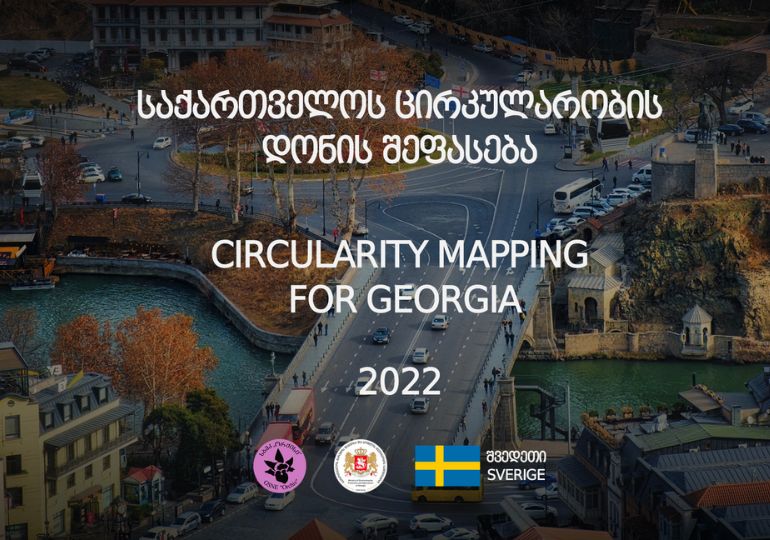”Georgia is 1.3 per cent circular and shows a great potential to increase its circularity”
The circularity mapping is a complex process. To perform it, a task group of international and national experts of local CSO Georgian Society of Nature Exploders “Orchis”, through funding of the Government of Sweden and in close cooperation with the Inter-Ministerial Coordination Board of the Government of Georgia, assessed economic sectors of Georgia in terms of circularity. At the initial stage a screening exercise was conducted to select out of the 90 economic activities listed in the register of National Statistics Office of Georgia those sectors, which may be promising for transition to circular models of economy. As a result of the screening, 14 sectors have been identified as having potential for developing circularity. Subsequently, a deep dive of these sectors was conducted which included mass flows of materials, losses and wastes generated, share of recycled wastes and estimation of potential for recycling. National quantitative circular economy policy targets and circular ambitions were recommended, sectoral opportunities identified, sector-specific policy options were defined and a set of recommendations for the Circular Economy Roadmap and Strategy for Georgia were developed. The conclusion was that Georgia is 1.3% circular—leaving a circularity gap of 98.7%. However, it is possible to increase its level of circularity up to 6.6% in the coming 5/10 years and for some sectors, like agribusiness, the potential is even much higher and can reach 25%.
Transitioning to circularity
We are living in the Anthropocene: a geological epoch where our human imprint on the planet is causing increasing devastation to the natural world. Our linear ‘take-make-waste’ economy has made throw-away culture the norm, putting increasing pressure on natural resources and our climate. The transition to a circular economy requires a radical change in the way we produce and consume. Products should be designed for durability, upgradeability, reparability, and reusability. Companies should develop new business models generating revenue streams from services rather than products, while making more efficient use of resources and materials, and consumers should use products efficiently and discard them in such a way that they can be turned into secondary materials that can enter a new production-consumption cycle.
The circular economy concept is gaining attention in light of increasing consumption and resource use by a fast-growing population with rising standards of living. This is a new economic model that represents sustainable progress towards efficient green growth. Due to its expected environmental, climate, social and economic benefits, the circular economy is not only being strongly promoted by the EU institutions, as well as a growing number of national and local governments, but it is also attracting increasing attention from the business community and from public and private financiers.
Like with any systemic change, the transition to the circular economy requires several elements of the system to change simultaneously. The inertia and resistance of the current linear economic systems prevent the transition from occurring. Concerted actions by a host of stakeholders are needed for change. Governments at all levels, businesses, innovators, academia, investors, and consumers all must play their distinct roles and contribute to the process.
The recent years have seen a rapid development of the circular economy business models such as resource recovery, remanufacturing, and product life extension, sharing and product service. However, the market penetration of circular business models remains limited and there is a considerable scope for their future growth. Such growth should be supported by a well-functioning, non-distortive policy, and regulatory framework, which ensures a level playing field for circular economy business models by eliminating legacy subsidies that reward linear behaviours and by fully pricing in risks and externalities associated with the linear production and use of materials. Such a framework facilitates and accelerates the allocation of capital to circular investments and activities. It stimulates private sector finance and allows optimal leverage of public funding.
Public authorities and project promoters play an important role in creating circular businesses. The principal objective should be to succeed in correctly identifying, conceptualising and developing circular business models and projects that are both sound and bankable, and support a long-term development vision and strategy for the transition to the circular economy. There is also a need for partnership, cooperation, and coordination between various stakeholders. Weak policy coordination remains a common feature across countries. At governmental level, responsibility for the areas of policy relevant to circular economy tends to be distributed across more than one ministry. Often, existing decision-making structures and processes do not deal effectively with cross-ministerial topics. Better coordination and cooperation between governing bodies would result in addressing the above issues. Policy coordination requires involvement of stakeholders outside government. The importance of involving private-sector stakeholders, both employers and employees, in policy decisions and in the design of skills development measures is essential.
It is important to strengthen national and local governmental policies to support the widespread implementation of circular business models through, among other things, setting quality standards for recycled and reused materials, or by pushing for innovative initiatives. Further work is required to ensure circular business models become the best option for companies willing to gain competitive advantage and maintain their market share while aligning their goals with society’s goals. Barriers both at the company level and along the value chain, as well as from a policy perspective still persist. Overcoming these obstacles and seizing opportunities is key for the transition towards a more sustainable and competitive economic model.
The first step to introduce policies and strategies conducive to the accelerated transition to circularity is to set the baseline conditions through mapping of the circularity and assessing sectoral potential for further policy actions. Through financial support of the Government of Sweden, this task has been recently completed in Georgia by a group of international and local experts formed by local CSO Georgian Society of Nature Explorers “Orchis” (GSNE “Orchis”) who worked closely with the Inter-Ministerial Coordination Board and other representatives of the Government of Georgia (GoG) over a period of two years. It resulted in the preparation of the Circularity Mapping Report and recommendations to policy makers and project promoters at various national levels to launch actions to raise awareness and improve skills required by public bodies to accelerate the transition to the circular economy. It also provided recommendations for the key actions to be included in the development of the Circular Economy Roadmap encompassing various groups of stakeholders, including financial and non-financial policy makers and project promoters regarding measures which need to be adopted to achieve accelerated transition to circularity.
What has already been accomplished in Georgia
Georgia is currently a clear regional leader in the accelerated path towards circularity. With the general objective of replacing the ‘end-of-life’ concept with an economic system that closes material loops, Georgia embarked in 2018 on an accelerated path to transition to the circular economy with enacting the concept of the Extended Producers Responsibility (EPR) in the national Waste Management Code. With the concerted efforts of the Government of Georgia (GoG), civil society organisations, academia and international partners, Georgia has also initiated the development of the National Circular Economy Strategy and Roadmap based on a comprehensive multidimensional approach that covers production, consumption, waste management, secondary raw materials, innovation, investments as well as ongoing initiatives in different sectors implemented by different players that are at different stages of the value chain or different stages of development.
The GoG strongly believes that Circular Economy strategies benefit from inclusive partnerships, and different players capable of providing the knowledge, funding, or improving the regulation need to work together to bring about a paradigm shift with the general objective of replacing the ‘end-of-life’ concept with an economic system that closes material loops.
The Government of Sweden is one of the key advocates of the circular transformation in Georgia, and through the Swedish International Development Cooperation Agency (SIDA) has been funding different initiatives of the GoG and non-governmental sector, among them the Circular Economy Programme implemented by CSO GSNE “Orchis” in close cooperation and coordination with the GoG and especially the Ministry of Environmental Protection and Agriculture.
Circular Economy Programme in Georgia and Circularity Mapping for Georgia
The mentioned Circular Economy Programme of GSNE “Orchis” comprises two elements – the first one encompasses an awareness raising aiming at promoting the Circular Economy and providing recommendations to various groups of key stakeholders, including policy makers, financial institutions, and project promoters how to accelerate the implementation of circular economy principles at various levels of economic activity.
As the programme on raising awareness on the Circular Economy in Georgia was received very positively by engaged stakeholders, the GoG has approached SIDA to provide support to map the circularity of the Georgian economy with a view to provide recommendations to develop a Roadmap to Circularity and adopt a Circular Economy Strategy. This initiative – the second element of the Circular Economy Programme – had been approved and financed by the Government of Sweden over the past two years.
To perform circularity mapping, which is a complex process, economic sectors of Georgia have been assessed in terms of circularity. At the initial stage a screening exercise was conducted to select out of the 90 sectors (economic activities) listed in the register of National Statistics Office of Georgia those sectors, which may be prospective for transition to circular models of economy. Two simple criteria have been used for screening: (i) economic criteria characterizing the role of the sector in the country’s economy (input in GDP; annual production; number of employees); and (ii) volumes of waste generated or losses. As a result of the screening, 14 sectors have been identified as having potential (medium; high; extremely high) for developing circularity. Subsequently, the task team took a deep dive in the 14 selected sectors and prepared a snap-shot description of each, including mass flows of materials (raw materials, products, by-products, and wastes), losses and wastes generated, share of recycled wastes and estimation of potential for recycling. The task team also recommended appropriate national quantitative circular economy policy targets and circular ambitions, identified sectoral opportunities, defined sector-specific policy options, and developed a set of recommendations for the Circular Economy Road Map and Strategy for Georgia.
All these has been built on extensive consultations and interviews with relevant governmental agencies and business leaders, review more than 80 most relevant reference documents and analysis of available statistical data.
The circularity mapping was implemented by the task team of GSNE “Orchis” formed from 13 international and local experts representing the highest level at various economic sectors. The mapping process took 24 months of intensive work, and was completed at the end of October 2022. Throughout this period, the task team interacted closely with the Inter-Ministerial Co-ordination Board of the GoG consisting of 36 experts from various ministries and governmental agencies under the leadership of Acad. Solomon Pavliashvili – Deputy Minister at the Ministry of Environmental Protection and Agriculture of Georgia. Together with the main outcome – the establishing of the circularity level of the economy of Georgia and developing relevant recommendations, the mapping process has demonstrated an efficient interaction between the civil society and public sectors towards the desired results.
What are the key findings of the mapping process
The results of the work show that Georgia is 1.3% circular — leaving a significant circularity gap of more than 98.7%. This means that the country’s economy is largely linear, and the vast majority of resources Georgia uses to satisfy its needs come from virgin sources. More than 315 million tonnes of resources are entering Georgian economy each year, amounting to nearly 78 tonnes per person — a figure that has continued to grow over recent years.
Georgia’s circularity metric of 1.3% does not mean that 98.7% of the materials flowing through its economy go to waste. The circularity gap is composed of a range of elements: many materials (40 million tonnes) are added to stock in the form of buildings and infrastructure, while around 1.4 million tonnes of materials are represented by biomass with the potential for cycling, such as wood products and food crops. While materials in both these categories can be cycled, quite some time will pass before this is possible. It is important to stress that while developing a roadmap to circularity, it is crucial to focus on design of new materials and products to ensure that end-of-life cycling will be feasible and of high value. Non-circular flows, such as fossil fuels, and non-renewable inputs together represent significant part of the gap. Georgia’s most critical goal will be cutting this while boosting its circularity metric—especially as stock build-up will continue to grow due to population growth, the country’s geography, and an appetite for bigger houses, among other factors. The target for coming 5/10 years will be to increase the level of circularity from current 1.3% up to 6.6%.
During the initial screening of sectors of Georgian economy, the team of experts selected 14 sectors, which seemed to have the highest potential for developing circular models of economy. Overview of these sectors has demonstrated that their current level of circularity is low for each separate sector. The losses and waste generation are significant in each selected sector, while the reuse of materials, recycling of wastes or recovery of materials, as well as efficient use of resources is poor. At the same time, most of the selected sectors have significant potential for improving performance and circularity indicators. The experts have also identified priorities within each of the selected sectors. The analysis confirmed the preliminary hypothesis that one of the key sectors with the highest circularity potential is agribusiness.
For further preparation of the Circularity Roadmap and the National Strategy for Circular Economy, the group of experts analysed key gaps and provided several financial and non-financial policy recommendations. In addition, based on the work recently carried out by other group of experts in the preparation of the Circularity Gap for Sweden, the task team recommended to further explore during the preparation of the Circularity Roadmap, various scenarios to shift the Georgian economy towards circularity. These scenarios could include the following: 1) Construct a circular built environment, 2) Cultivate a thriving food system, 3) Make manufacturing circular, 4) Reshape extractive industries, 5) Drive clean mobility forward, and 6) Design conscious consumables. While individual scenarios may have limited impact, all together, they can significantly increase Georgia’s circularity.
Georgia’s potential to increase circularity
For mapping circular economy opportunities, the ReSOLVE framework has been used as it offered a structure for a systematic screening of opportunities to identify and map opportunities. It has been an iterative exercise that began with a high-level mapping for each focus sector derived from existing circular economy literature. Thereafter, it has been verified and fine-tuned with sector stakeholders and experts to ensure that the mapping covered all relevant opportunities. The key focus of the mapping exercise has been to create an overview of opportunities by sector. The key principles of the circular economy can translate into six business actions: Regenerate, Share, Optimise, Loop, Virtualise, and Exchange – together, the ReSOLVE framework.
The aggregated input in GDP of the sectors of economy preselected at the screening stage and used in this assessment, constitutes 52.9% of Georgia’s entire GDP. So far as the selected sectors are exactly those, which have tangible impact on circularity, the current and targeted levels of circularity have been calculated based on indicators related to these selected sectors. It has been assumed, that the dismissed sectors have low impact on overall circularity. Each sector has been weighted based on its share in GDP. The weight has been then multiplied on the individual indicators of current and target circularity and further summed to derive the integral figure of circularity for Georgia’s economy.
Sectors with the highest circularity potential in Georgia
| Annual crop production | Construction |
| Permanent crop production and manufacture of food products | Manufacture of other non-metallic mineral products |
| Grape cultivation and wine making | Manufacture of basic metals |
| Animal husbandry and manufacture of food products | Electric power generation, transmission and distribution |
| Logging and wood products | Sewerage; Waste collection, treatment and disposal activities; Waste utilization, remediation activities and other waste management services |
| Fishery and fish processing | Oil and gas production and transportation |
| Mining and quarrying (except oil and gas extraction) | Accommodation and food service activities |
The team of experts has also prioritised and clustered industries according to their circularity potential. This entailed splitting the entire set of economic industries represented in the country into groups of the same type according to the criteria of circularity (economic and environmental indicators, resource consumption, material, and waste flows), indicators characterizing key players and the process of sector administration. The main conclusion was that all of the preselected 14 sectors have tangible potential for shifting towards the circular models of economy, some of them as high as 25 per cent and no one of these sectors should be discarded during the development of the CE transition strategy and action plans. Agriculture seems to be the highest priority sector for Georgia, as six sectors out of the preselected 14 represent subsectors of Agriculture.
What should be the next steps
Commitments of Georgia in the field of climate action, environmental protection and sustainable development that were made under different international agreements and treaties require respective actions. Limited local resources and dependence of the country on imported materials, environmental pollution and growing degradation of biological resources call for urgent measures to address these issues. Circular transformation with its potential for accelerating green growth, reduce impact on climate and other environmental features can be a way to tackle these challenges.
The next step to the accelerated transition to circular economy requires preparation of a national roadmap to guide the country through this process and ensure uninterrupted progress. It should be a document that includes a vision as well as goals and tangible actions that will accelerate Georgia’s transition towards a circular economy. All these should compile views of key stakeholders on the essential changes and actions needed for the circular transformation.
The roadmap should define the most important steps, different roles, timeline, preconditions, resources, etc. Furthermore, the roadmap should create a shared mindset for promoting the circular economy among all stakeholders including government, policy makers, financiers, businesses, academia, and non-governmental organisations. The shared mindset across societal sectors is necessary to identify the most effective means to bring systemic economical change. Forming a shared understanding and vision about the necessary work is the key to a successful process. It is also important to outline how the roadmap may be linked to other processes related to the transformation to a circular economy.
There is also a need for a framework document that can guide the GoG through the transition process. Such a framework should include the national strategy and action plan for circular economy that should lead the country to sustainable consumption and production through predefined strategies and actions that provide needed incentives, tackle challenges and overcome obstacles holding back the development of the circular economy in Georgia. S

Dr Dariusz Edward Prasek
International Consultant on Circular Economy Issues, Team Leader, GSNE “Orchis”, To Map Circular Economy in Georgia Project
Doctor in Environmental Engineering, Independent International Expert in Sustainable Financing, Environmental, Social and Governance Areas. Former Director of Operations in Environmental and Sustainability Department of the European Bank for Reconstruction and Development.

Dr Medgar Tchelidze
Key National Expert in Sustainable Development, Deputy Team Leader, GSNE “Orchis”, To Map Circular Economy in Georgia Project
Doctor in Biological Sciences, Expert in Environmental, Social, Governance and Sustainability Areas.
















